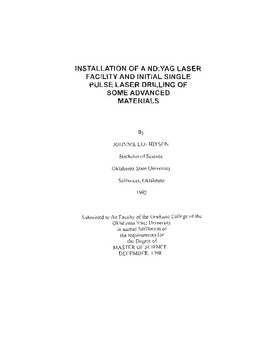| dc.description.abstract | In this investigation, a Nd:YAG laser (maximum nominal pulse energy: 90 joules per pulse @ 4.00 ms pulse width) (maximum power: 400 walls nominal) was used to study the interaction of the laser on various advanced cutting tool materials during drilling. This project began with the acquisition and installation of the Controls Laser's Nd:YAG laser at the Mechanical Aerospace Engineering Research Laboratory of the Oklahoma State University. This was followed by the alignment of the optical path of the laser beam. Peripheral safety equipment was acquired and installed. A 3-axis CNC motion control system was integrated with the laser system to provide motion control and firing of the laser from a more modern. p.c. based system. A review of literature was conducted in the general area of lasers and laser materials processing with the focus on Nd:YAG laser in particular. It was found that much of the research has been conducted with the CO2 laser and a comparatively limited amount with Nd:YAG laser. Calibration studies were performed to characterize the operating characteristics of the laser using a laser power probe before conducting experiments since, upon review of the literature and reference material, it was noted that factors such as usage and alignment can affect the performance. Subsequently, initial single pulse laser drilling experiments were conducted at four voltage levels (700 Y, 1050V, 1350 Y and I700V) and three pulse durations (0.65 ms, 1.50 ms, and 4.00 ms) on a range of advanced 1001 materials (AI 20 3, Ah03,TiC, SiC whisker reinforced AhOrZrOz, Si)N4� SiAtON, TiC-TiN cermet with Ni-Mo binder, WC-6%Co. WC6% Co +TiN coating, and polycrystalline cubic boron nitride) which covers the whole spectrum of advanced tool materials. The primary purpose of the single pulse laser drilling tesL~ is to obtain experimental data of the cross sections of the material removed from various tool materials by the laser beam to correlate with the analytical thermal modeling currently underway at O.S.U. by Hou and Komanduri. The cross sections of the holes drilled were examined using an optical microscope with a sample holder with micrometer adjustments to obtain dimensional data and a scanning electron microscope to obtain micrographs. | |
